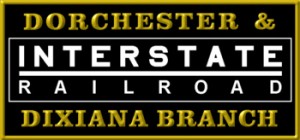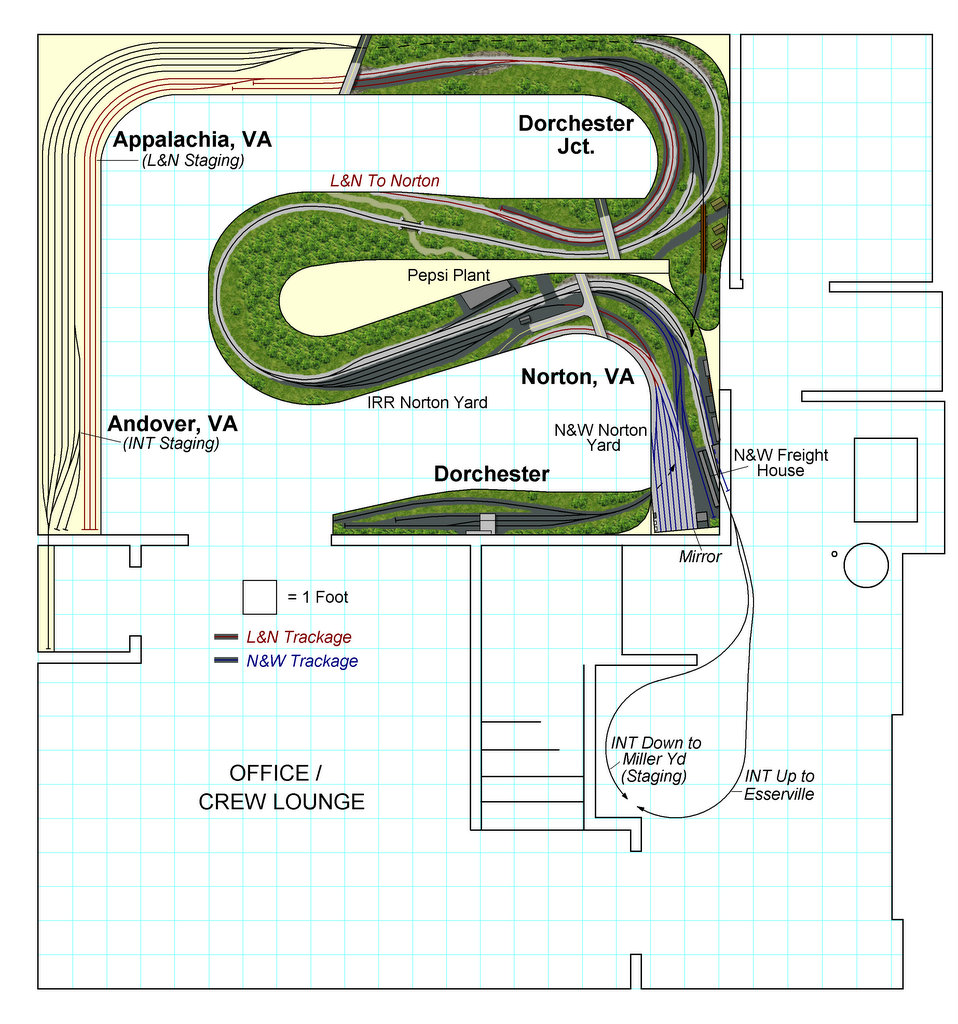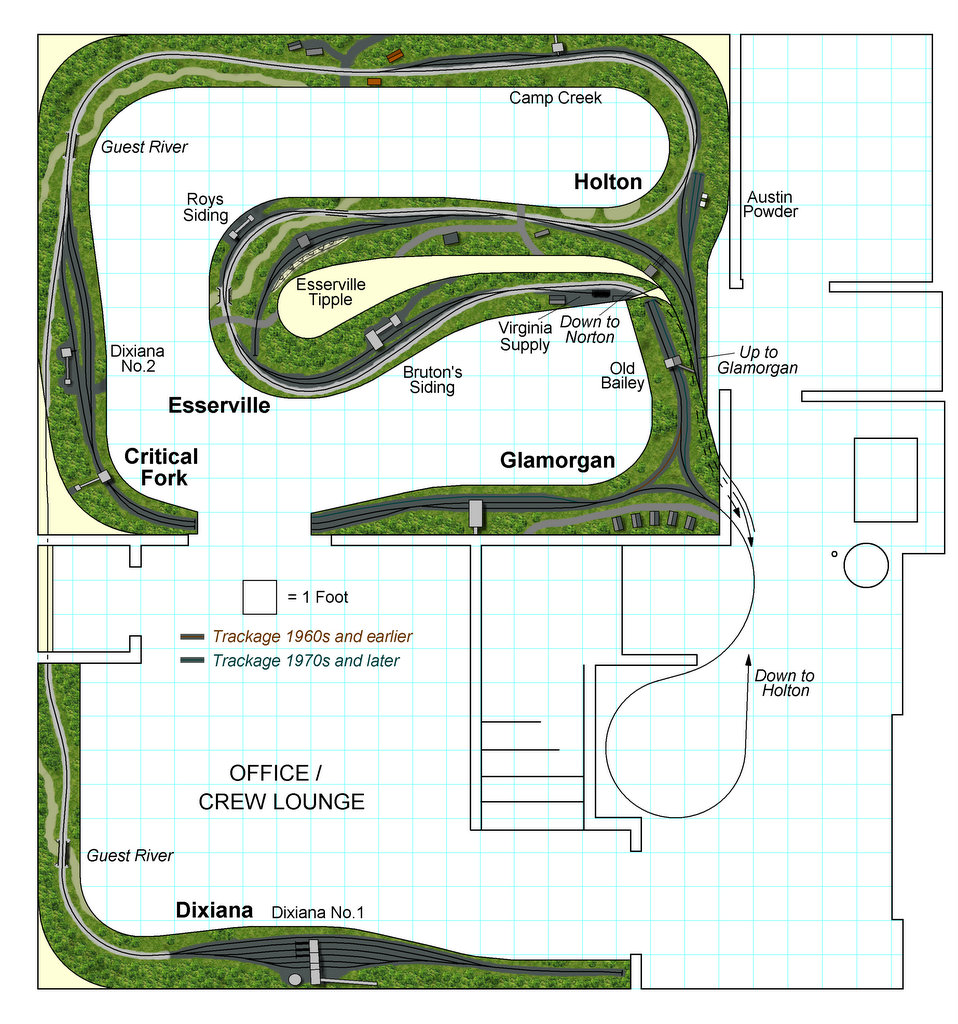- Size: 21′ x 28′
- Scale: HO
- Minimum Radius: 30″ (visible)
- Minimum Aisle Width: 36″
- Designed by Dan Bourque
 The Interstate’s operations in and around Norton, VA and up the the Dixiana Branch were busy and interesting. In addition to the massive amounts of coal being generated on the branch, the mainline also saw a lot of movement of interchange traffic, particularly between the L&N at Dorchester Jct. and the Clinchfield at Miller Yard, the eastern end of the Interstate’s mainline. This layout (which was partially built in my former basement before I moved) is designed to capture the operations and loaders of this area as faithfully as possible within the space given. While not quite switch-for-switch, the track arrangements for yards, industries and tipples are about 85% correct, and all operations in the modeled sections are included in the track plan.
The Interstate’s operations in and around Norton, VA and up the the Dixiana Branch were busy and interesting. In addition to the massive amounts of coal being generated on the branch, the mainline also saw a lot of movement of interchange traffic, particularly between the L&N at Dorchester Jct. and the Clinchfield at Miller Yard, the eastern end of the Interstate’s mainline. This layout (which was partially built in my former basement before I moved) is designed to capture the operations and loaders of this area as faithfully as possible within the space given. While not quite switch-for-switch, the track arrangements for yards, industries and tipples are about 85% correct, and all operations in the modeled sections are included in the track plan.
The Layout
This was the last of several track plans for my previous basement, and it reflects my “givens-and-druthers.” Because there are already many large layouts being constructed in my neck-of-the-woods, I wanted to build something that could be operated with fewer people in a shorter amount of time so I don’t burn out the area’s operators! This layout can be operated by a crew of 1-4. I chose the Interstate because Ed and Hugh Wolfe’s excellent book series on the railroad has captivated me. I love switching, so a busy branch line appeals to me (the Dixiana Branch handled between 2-4 mine runs per day). In the second Interstate book, Appalachian Coal Hauler, Hugh Wolfe describes every switching move and challenge they used to serve the tipples. Consequently, I wanted my track arrangements to be as close to the real-deal as possible so crews could practically use Hugh’s descriptions to work the tipples the same way they were actually worked. I also wanted running space between scenes where it’s supposed to be. Many of my early plans compromised this to get more operations or other railroads onto the layout, and I was never really happy with them; this plan gives up a lot to get the space, but it fits my style better. The easy-to-access staging yards are another bonus I’m happy I don’t have to compromise on.
The L&N and N&W are both operational interchange partners on the layout. The L&N’s function is to provide Clinchfield-bound traffic to the Interstate at Dorchester Jct. In reality, the L&N continued on to Norton and a connection with the N&W, but I left this out to focus on the Interstate. The N&W has no staging, so in effect, the N&W forms its own little switching layout with Interstate interchange being one of its chores. In addition to the interchange, there are 7 industries and a very small classification yard. This section of the layout is operational in my basement, and it takes 60-90 minutes to complete the N&W’s chores!
I also care a lot about creature comforts. Because of this, I wanted 36″ minimum aisles and no duck-unders. The basement was already finished when I moved in, and this has been a mixed blessing. It’s been frustrating designing around a poorly placed (by layout standards) bathroom, closet and bar. I could have done a much better track plan without them. However, it is VERY nice to have a room that already has a ceiling, walls and carpeting–it won’t take much effort to have a finished-looking layout area. Besides, the bathroom and refrigerator under the bar will come in handy during ops sessions.
Control is via Digitrax DCC. Because I don’t have many locomotives to control at once, I used a Digitrax Zephyr XTRA for the command station and a DCS100 for a booster. I also used Digitrax’s UR92 for two-way radio control from wireless UT4D throttles.
Lower Deck
Operations
I chose to model an area where the track and industries didn’t change much but the operation changed significantly over the years. This will allow me to run sessions for multiple eras by swapping out rolling stock and changing the train orders. The three primary eras will be 1965, 1970 and 1975.
1965
1965 was the last year the Interstate ran independently of the Southern. Motive power was bright RS-3s and most hoppers were the Interstate’s black 50 tonners, although the Southern influence was starting to show. Operations in the area consisted of the East Switcher to work the big mines on the Dixiana/Glamorgan branch, the Norton Switcher to handle the interchange and weighing operations in Norton and 2-4 Hill Crews which shuttled interchange between the L&N at Dorchester Jct and Clinchfield at Miller yard as well as worked some of the operations on the south end of the Dixiana branch. The coal tonnage was steady and the pace was laid back except for the nightly scramble to get cars off the Interstate to save per-diem charges. There was also a decent bit of non-coal traffic moving between Dorchester Jct and Miller Yard. The only operations on the layout not in place in 1965 were Austin Powder and Camp Creek, so I will take the structures off for these sessions.
1970
1970 operations weren’t too different from 1965, but the motive power was all Southern. The Southern was retiring some of their last F-units off of these mine runs, and they were being replaced with new GP38s. The hopper fleet was a mix of old Interstate and Southern twin hoppers (now primarily in captive service between mines and the huge transloader in Appalachia, VA) alongside Southern 70 and 100 ton hoppers. The Southern renamed the crews. The first and third mine runs served the Dixiana and Glamorgan operations while 2 Hill Crews worked the closer loaders and handled switching and interchange with the L&N, Clinchfield and N&W. All operations on the layout are essentially correct for this era.
1975
1975 operations changed significantly because the L&N was no longer routing its Clinchfield traffic over the Interstate. With the coal boom of the early 70s, the Southern simply could not (or chose not to) keep up with the demand, so the L&N secured traffic rights over the N&W from Norton to a connection with the Clinchfield at St. Paul, VA. The Southern crews, still 2 mine runs and 2 Hill Crews, were busy enough keeping up with all the coal loaders. Operations were streamlined more and the First Mine Run worked the Dixiana and Glamorgan areas while the Third Mine Run worked all the tipples which shipped “yellow balls” (the captive hoppers heading to Appalachia). All operations on the layout were operational in 1975, but the track arrangements at Glamorgan, in particular, had changed significantly (I’m willing to live with this).
This layout will normally be operated by a crew of 2-4. Only 2-3 trains will be on the layout at any given time, so extra operators become “conductors” who direct switching movements and manage the paperwork. There is PLENTY of switching for every train, enough to keep a 2-man crew busy. I plan on having most of my operating sessions be 12 scale hours long. This should take about 2 real hours and make sessions easy to squeeze into a weeknight. It also keeps operations varied from session-to-session with the “morning” session serving most of the big operations and delivering empties and the “evening” session scrambling to collect all the loads and get them to their interchange points by midnight. This also allows me to recycle power easily (avoids having to cut engines in staging or turn a train at Miller Yard) and gives me the option of serving mines twice per day. Between the 12-hour sessions and multiple eras, very few ops sessions will look the same.
Things I Like About this Plan:
- Lots of loaders
- Tons of switching
- Not crowded
- Enough room to keep operators comfortable
Things I Don’t Like About this Plan:
- No continuous running loop
- Need to hand-lay most of the switches
- N&W “switching layout” tail tracks too short
- Not enough space on Norton interchange tracks
Related Products:





